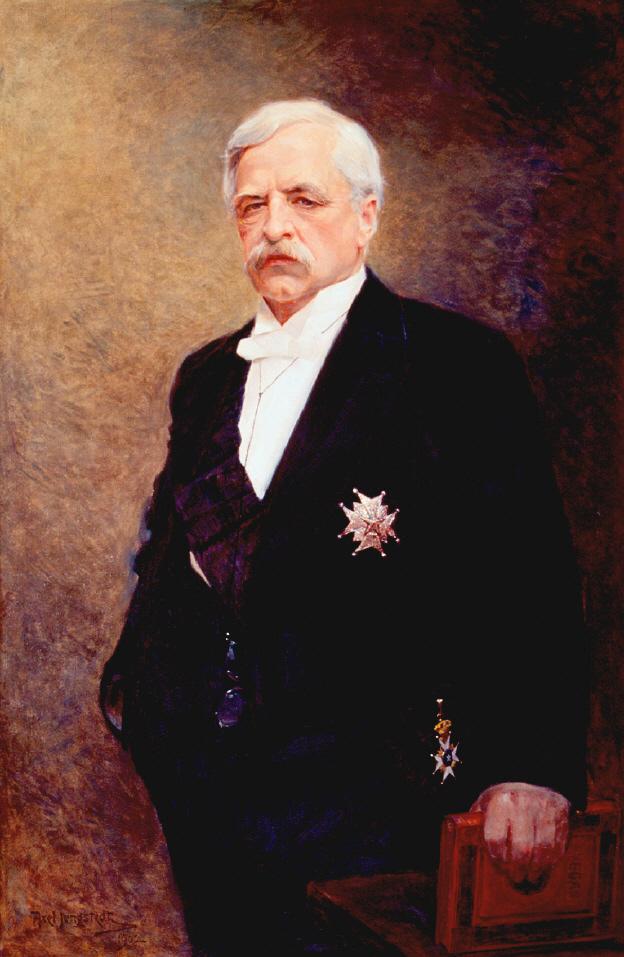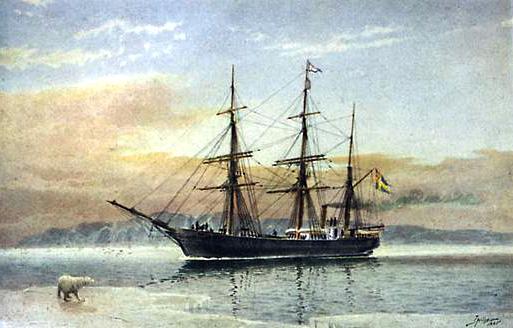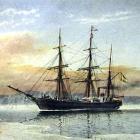
Portrait of Adolf Erik Nordenskiöld (1902)
Portrait of Adolf Erik Nordenskiöld (1902)
Adolf Erik Nordenskiöld by Axel Jungstedt (1902)
Courtesy of Center for History of Sciences, The Royal Swedish Academy of Sciences
Click here to view Wikimedia source.
 This work is licensed under a Creative Commons Attribution-NonCommercial-ShareAlike 3.0 Unported License.
This work is licensed under a Creative Commons Attribution-NonCommercial-ShareAlike 3.0 Unported License.
he Finnish-Swedish scientist Adolf Erik Nordenskiöld (1832–1901) was the first European explorer to sail through the Northeast Passage, which he did on an 1878–1879 expedition. Between the years of 1858 and 1883, he conducted a total of ten expeditions to the Arctic, which covered an area from Greenland and Spitsbergen all the way to the Bering Strait—a quantity and size, respectively, that is considered a feat for his time. He described his explorations in several publications in several languages, considerably expanding scientific knowledge of the polar reions. An expert on various subjects, including geology, mineralogy, cartography, meteorology, zoology, botany, history and ethnology, Nordenskiöld’s expeditions were among the best prepared and equipped at the time. As an expedition leader, he was as precise and accurate as possible, and his scientific expedition staff always included old and young scientists, in order to give the younger opportunities to learn from the older. He usually insisted that his staff also include at least one or two fellow Finnish countrymen. Among his many accomplishments, he charted Spitsbergen and the north coast of Siberia, and, later in life, he became a passionate collector of historical maps and books, which can be found today in the National Library of Finland as The Nordenskiöld Collection.
Nordenskiöld had extensive knowledge of Arctic history and conditions, and he seemed to have a high environmental literacy. (Environmental literacy is an organized way of thinking about the environment that includes knowledge, attitudes, and active involvement, and requires the ability to think beyond the conventional categories.) For example, on his first expedition to Spitsbergen in 1858, Nordenskiöld described how greedy eider hunters collected all the eggs and killed most of the birds for their feathers. It was a miracle that the bird colonies were not completely exterminated. A couple of years later he wrote: “If the hunters saved the birds, which they are now shooting just for the expensive feathers, and if they stopped collecting eggs from the beginning of July or took only the fresh eggs, perhaps the number of eiders would multiply.” Nordenskiöld’s concern for the environment was something new in Europe at that time.

Nordenskiöld was a celebrated hero after sailing the Northeast Passage and circumnavigating the Eurasian continent with his vessel the “SS Vega”.
Nordenskiöld was a celebrated hero after sailing the Northeast Passage and circumnavigating the Eurasian continent with his vessel the “SS Vega”.
Postcard by Jacob Hägg (1839–1931)
Click here to view Wikimedia source.
 This work is licensed under a Creative Commons Public Domain Mark 1.0 License.
This work is licensed under a Creative Commons Public Domain Mark 1.0 License.
Nordenskiöld often strayed far from prevailing scientific opinions. For instance, many of the distinguished scientists of the nineteenth century considered sailing through the Kara Sea, which was called the “ice house” of the Arctic Ocean, to the Siberian rivers to be an impossible task. Whalers had occasionally tried to enter the Kara Sea but failed, because of either thick floating ice or bad weather. But Nordenskiöld figured most of the ice would melt during the summer, when rivers such as the Ob and Yenisei would bring in masses of warm water, rendering the sea navigable during the autumn. Upon his successful journeys into the Kara Sea, Nordenskiöld found it full of life—e.g., huge isopods and serpent stars, masses of starfishes, and fish lice—proving scientific circles, who had previously believed the sea to be lacking in fauna, wrong.
Throughout his journeys, Nordenskiöld encountered and wrote about the various destructive changes in nature he observed and the vulnerability of the environment. His deep historical perspective on environmental change made him one of the pioneers in the awakening of environmental awareness in Europe.
How to cite
Niemi, Seija A.. “Nordenskiöld, an Explorer and Scientist from the North.” Environment & Society Portal, Arcadia (2012), no. 11. Rachel Carson Center for Environment and Society. https://doi.org/10.5282/rcc/3889.
ISSN 2199-3408
Environment & Society Portal, Arcadia
 This work is licensed under a Creative Commons Attribution-NonCommercial-ShareAlike 3.0 Unported License.
This work is licensed under a Creative Commons Attribution-NonCommercial-ShareAlike 3.0 Unported License.
2012 Seija A. Niemi
This refers only to the text and does not include any image rights.
Please click on the images to view their individual rights status.
- Heer, Oswald. Die schwedischen Expeditionen zu Erforschung des hohen Nordens vom Jahr 1870 und 1872 auf 1873. Zürich: Friedrich Schulthess, 1874.
- Kish, George. North-east Passage. Adolf Erik Nordenskiöld, his Life and Times. Amsterdam: Nico Israel, 1973.
- Nordenskiöld, Adolf E. “Account of an Expedition to Greenland in the Year 1870.” Geological Magazine Vol. 9, 97(1872): 289–306, 355–368, 409–427, 449–463, 516–524.
- Nordenskiöld, Adolf E. “Sketch of the Geology of the Ice Sound and Bell Sound, Spitzbergen.” Geological Magazine III (1876): 16–23, 63–75, 118 –27, 255–67.
- Nordenskiöld, Adolf E. “The Nordenskjöld Greenland Expedition.” Nature, Vol. 29, Nov. 1 (1883): 10–13, Nov. 8(1883): 39–42.
- Raurala, Nils-Erik, ed. Nordostpassagen från vikingarna till Nordenskiöld, 206–226. Helsingfors: Helsingfors Universitetsbibliotek, John Nurminens stiftelse, 1992.








